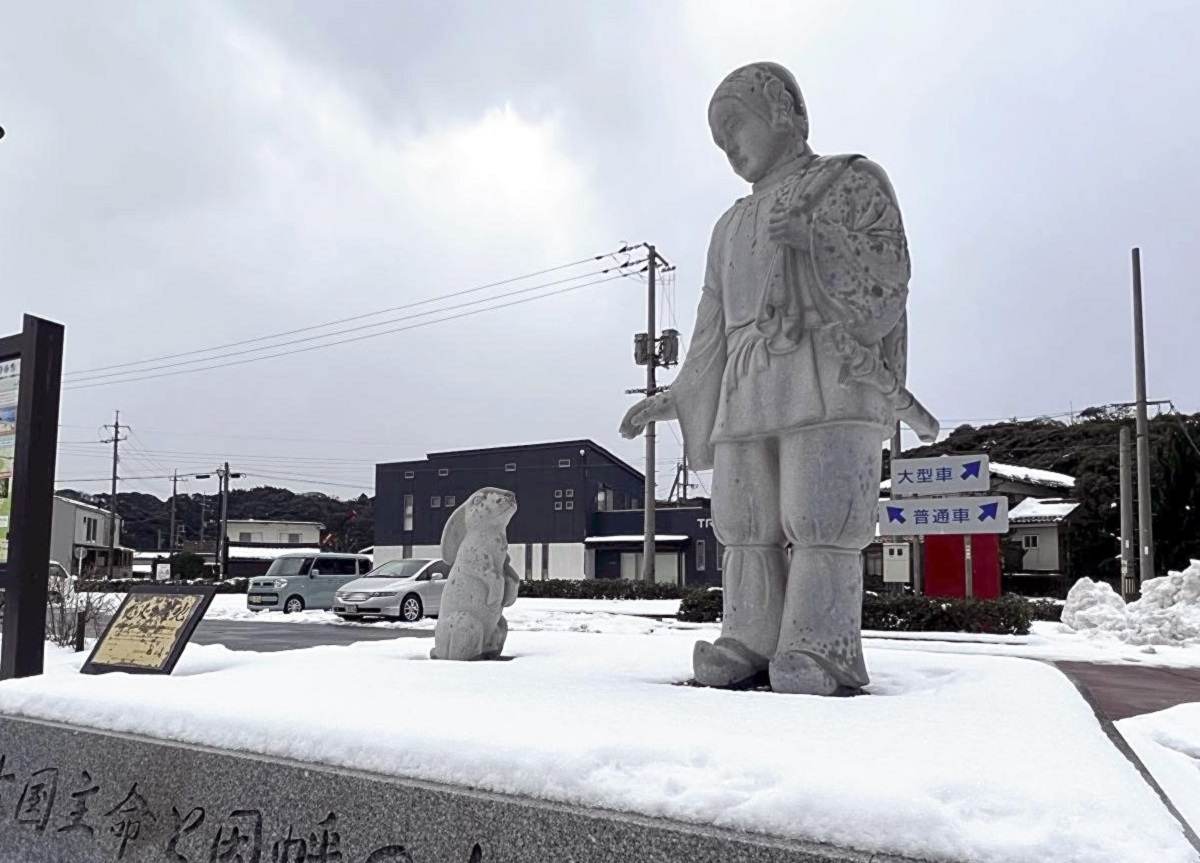
Stone statues of Okuninushi no Mikoto, right, and a rabbit stand near the Hakuto Shrine in Tottori City.
10:51 JST, March 4, 2023
TOTTORI — Residents of Tottori Prefecture are introducing visitors to many of the rabbit-themed legends associated with the area, hoping the upcoming Year of the Rabbit proves fortune-filled for the local tourism industry.
Among Japanese people, the most well-known legend is of the White Rabbit of Inaba, which has been passed down through generations in Tottori City.
The legend tells of a white rabbit living on Oki Island that wanted to cross the sea to Inaba, now an area around Tottori City. He couldn’t do this by himself, so he tricked some sharks into lining up across the sea and made it to Inaba by traversing their backs. The rabbit later revealed to the sharks that they had been deceived, which made them angry, so they plucked out all his hair.

The rabbit was then told by passing deities that his injuries would be cured if he washed them in seawater and exposed to the wind. He trusted them, but only suffered more pain.
Eventually, Okuninushi no Mikoto, a famous Japanese deity, helped restore the rabbit’s health by telling him to wash his body in fresh water and put on cattail reed seeds. In return, the rabbit introduced the deity to Princess Yakami, the most beautiful woman in Inaba.
Okuninushi, revered as the deity who created the nation, is enshrined at the Izumo Taisha grand shrine in neighboring Shimane Prefecture.
There are various theories as to which island the rabbit originated from, but the legend is said to have taken place on the city’s Hakuto Beach. Near the beach sits a shrine called Hakuto Shrine. “Hakuto” means “white rabbit” in kanji.
Attracting foreign visitors
During the first three days of the new year, about 30,000 people from inside and outside the prefecture visited Hakuto Shrine, three times the number of previous years. Visitor numbers increased after people shared on social media images of adorable rabbit statues that are placed along a path leading to the shrine.
Near the shrine’s entrance, statues of Okuninushi no Mikoto and a white rabbit stand next to each other. As the myth describes the rabbit’s recovery from his injuries, the shrine is said to bring blessings for “healing” and “recovery.” The story of the rabbit pairing the deity with Princess Yakami has made the shrine even more famous for “matchmaking” blessings.
Lucky stones emblazoned with the Chinese character “en,” meaning “ties,” are piled up at the foot of the rabbit statues lining the path to the shrine. As the stones are regarded to bring luck for matchmaking, the statues have been attracting the interest of photographers. A pond where the white rabbit is said to have cleansed his wounds is also popular.
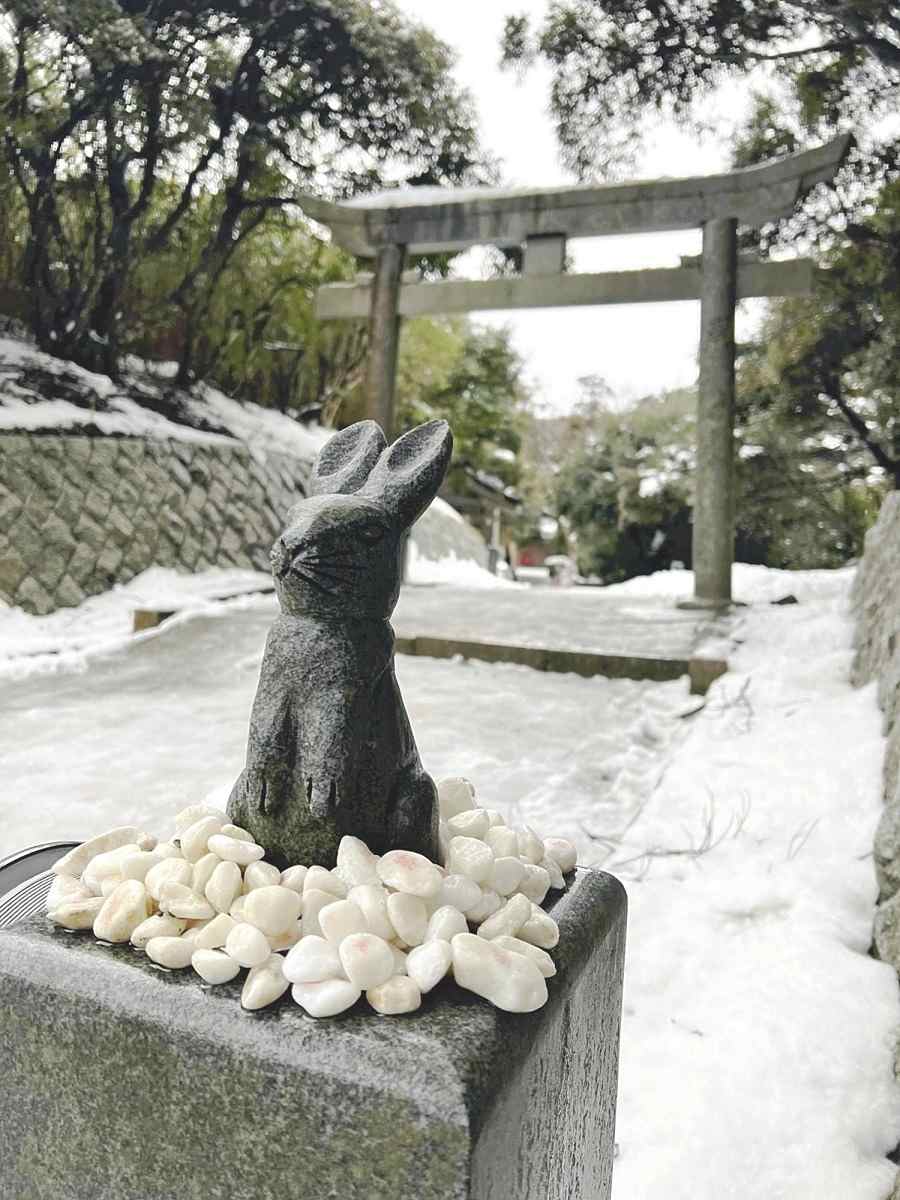
A stone statue of a rabbit stands on the side of the path leading to the Hakuto Shrine.
“Many people love rabbits. Hakuto Shrine will be the center of tourism in the prefecture this year, the Year of the Rabbit,” said Hirokuni Kawakami, the 74-year-old chief priest of the shrine.
Tottori Prefecture is also home to many other places and items associated with rabbits. For example, there is another legend featuring a white rabbit in Yazu.
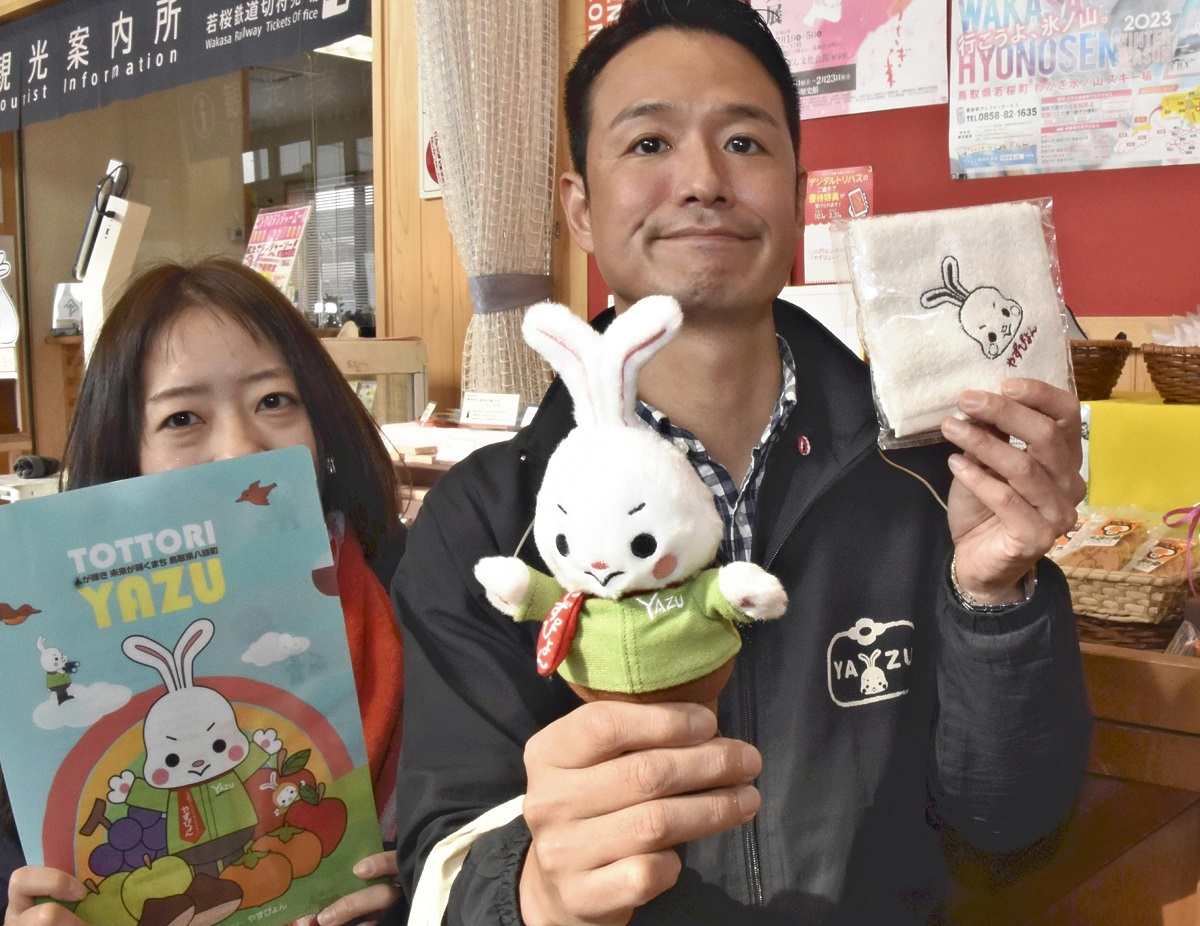
Staff hold goods of Yazu town’s rabbit character.
It is said that when the Amaterasu Omikami, goddess of the sun, descended onto a local mountain looking for a place to build a temporary shrine, a rabbit appeared and guided her to ridges on the mountain. Amaterasu is said to be an ancestor of the present Imperial family. In Yazu, there are efforts to make use of this legend to revitalize the town, through efforts such as using a rabbit mascot character.
On Jan. 9, staff members of the Tottori prefectural government’s tourism and exchange bureau donned rabbit headgear and prayed for the revival and growth of the local tourism industry at Hakuto Shrine.
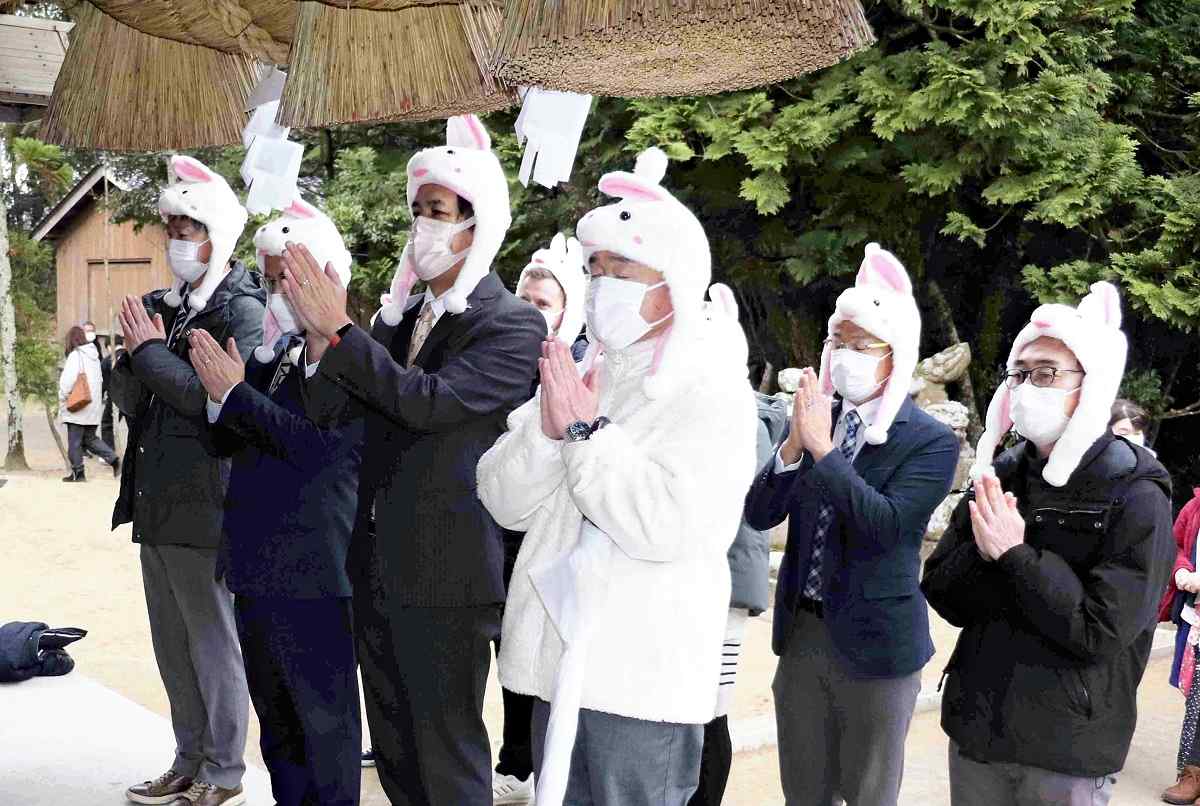
Staff members of the Tottori prefectural government’s tourism and exchange bureau, wearing rabbit headgear, pray at the Hakuto Shrine.
“We hope that the tourism and restaurant industries will be ‘revived’ like the white rabbit saved by Okuninushi no Mikoto, and that they will make a leap forward like a hopping rabbit,” said Shunichi Suzuki, director of the bureau.
The bureau plans to hold rabbit-related events to revive the tourism industry in the prefecture, which has been hit by the coronavirus pandemic. It has already launched efforts to resume accepting foreign visitors to Japan, such as by using a rabbit theme to promote the prefecture to travel agencies in Taiwan.
“A myth with narrativity that has not been well-known should resonate with people overseas as well,” Suzuki said.
New ‘station chief’
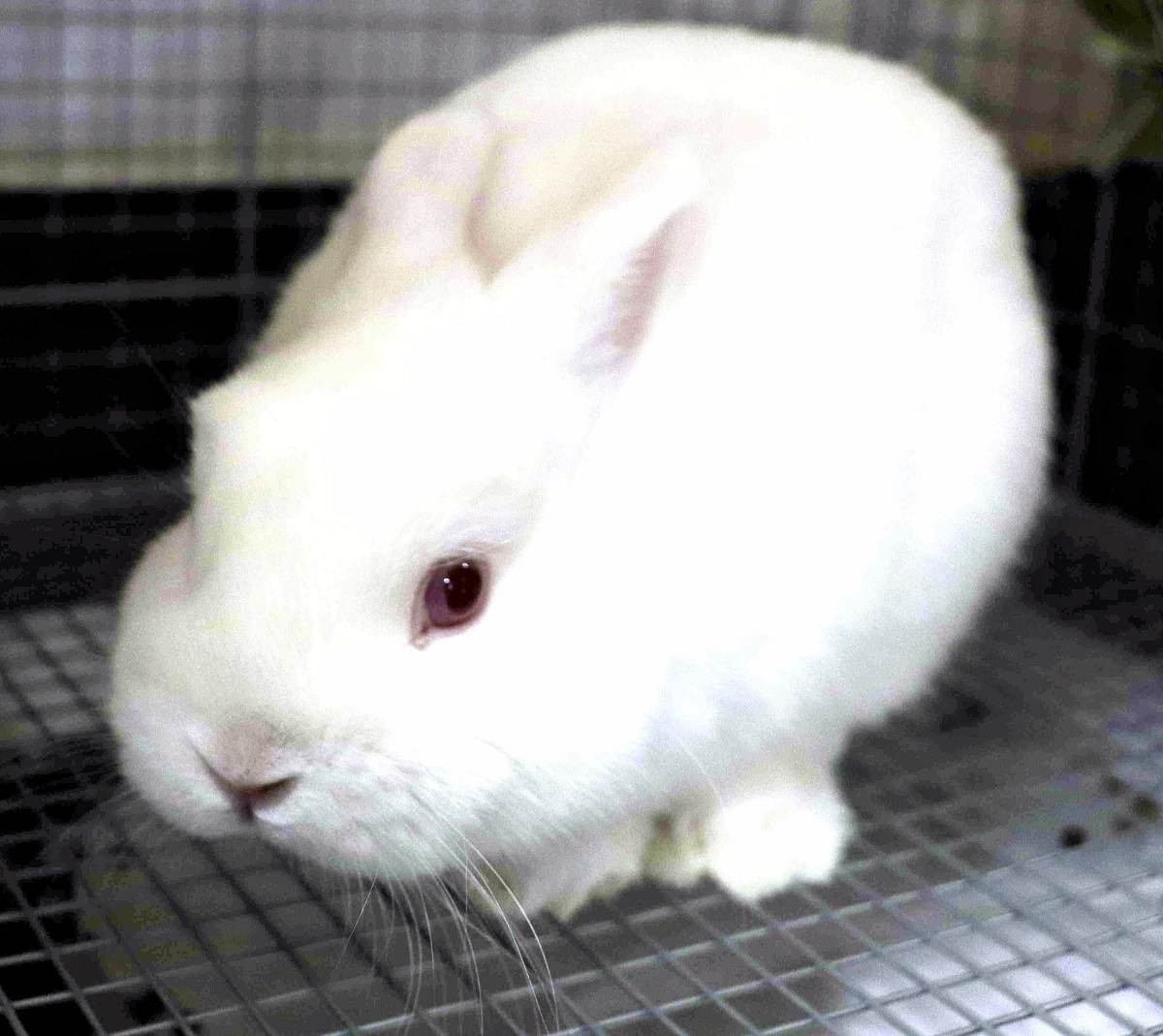
Enishi, the second “station chief” rabbit at the “Shinwa no Sato Shirousagi” roadside rest area in Tottori
Rest areas known at “Michi-no-Eki,” or “roadside station,” dot roads around the nation, and one in Tottori Prefecture featuring rabbits has a new “station chief.”
In January, a white rabbit named Enishi assumed the post of welcoming visitors at the Michi-no-Eki called “Shinwa no Sato Shirousagi” (Village of myth: White rabbit) located near Hakuto Beach.
“Mikoto,” the first rabbit to take the post in 2009, died in late November last year, and Enishi became the second station chief on Jan. 1. Born in Hyogo Prefecture last July, the new station chief is said to have a “gentle personality.”
The name “Enishi,” chosen from among suggestions solicited from the public, means “connections.”
"Features" POPULAR ARTICLE
-

Sanrio to Open Museum in Yamanashi Pref. Dedicated to Founder, Exhibits Include Hello Kitty, Other Characters
-

Autumn Foliage Surrounds Visitors to Tokyo’s Showa Kinen Park
-

My Daughter No Longer Speaks to Me, But I Want to See Her and My Grandchild
-

Kumamoto: Public Bath Refurbished as Library Where You Can Chat, Take Photos
-

Frozen Vegetables: Demand Rises for Convenient, Tasty Domestic Produce
JN ACCESS RANKING
-

Tokyo Economic Security Forum to Hold Inaugural Meeting Amid Tense Global Environment
-

Keidanren Chairman Yoshinobu Tsutsui Visits Kashiwazaki-Kariwa Nuclear Power Plant; Inspects New Emergency Safety System
-

Imports of Rare Earths from China Facing Delays, May Be Caused by Deterioration of Japan-China Relations
-

University of Tokyo Professor Discusses Japanese Economic Security in Interview Ahead of Forum
-

Japan Pulls out of Vietnam Nuclear Project, Complicating Hanoi’s Power Plans

























